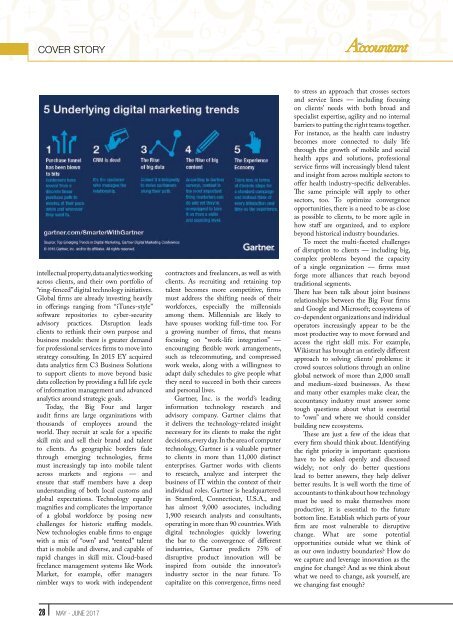The Accountant-May-June 2017
You also want an ePaper? Increase the reach of your titles
YUMPU automatically turns print PDFs into web optimized ePapers that Google loves.
COVER STORY<br />
intellectual property, data analytics working<br />
across clients, and their own portfolio of<br />
“ring-fenced” digital technology initiatives.<br />
Global firms are already investing heavily<br />
in offerings ranging from “iTunes-style”<br />
software repositories to cyber-security<br />
advisory practices. Disruption leads<br />
clients to rethink their own purpose and<br />
business models: there is greater demand<br />
for professional services firms to move into<br />
strategy consulting. In 2015 EY acquired<br />
data analytics firm C3 Business Solutions<br />
to support clients to move beyond basic<br />
data collection by providing a full life cycle<br />
of information management and advanced<br />
analytics around strategic goals.<br />
Today, the Big Four and larger<br />
audit firms are large organizations with<br />
thousands of employees around the<br />
world. <strong>The</strong>y recruit at scale for a specific<br />
skill mix and sell their brand and talent<br />
to clients. As geographic borders fade<br />
through emerging technologies, firms<br />
must increasingly tap into mobile talent<br />
across markets and regions — and<br />
ensure that staff members have a deep<br />
understanding of both local customs and<br />
global expectations. Technology equally<br />
magnifies and complicates the importance<br />
of a global workforce by posing new<br />
challenges for historic staffing models.<br />
New technologies enable firms to engage<br />
with a mix of “own” and “rented” talent<br />
that is mobile and diverse, and capable of<br />
rapid changes in skill mix. Cloud-based<br />
freelance management systems like Work<br />
Market, for example, offer managers<br />
nimbler ways to work with independent<br />
contractors and freelancers, as well as with<br />
clients. As recruiting and retaining top<br />
talent becomes more competitive, firms<br />
must address the shifting needs of their<br />
workforces, especially the millennials<br />
among them. Millennials are likely to<br />
have spouses working full-time too. For<br />
a growing number of firms, that means<br />
focusing on “work-life integration” —<br />
encouraging flexible work arrangements,<br />
such as telecommuting, and compressed<br />
work weeks, along with a willingness to<br />
adapt daily schedules to give people what<br />
they need to succeed in both their careers<br />
and personal lives.<br />
Gartner, Inc. is the world’s leading<br />
information technology research and<br />
advisory company. Gartner claims that<br />
it delivers the technology-related insight<br />
necessary for its clients to make the right<br />
decisions, every day. In the area of computer<br />
technology, Gartner is a valuable partner<br />
to clients in more than 11,000 distinct<br />
enterprises. Gartner works with clients<br />
to research, analyze and interpret the<br />
business of IT within the context of their<br />
individual roles. Gartner is headquartered<br />
in Stamford, Connecticut, U.S.A., and<br />
has almost 9,000 associates, including<br />
1,900 research analysts and consultants,<br />
operating in more than 90 countries. With<br />
digital technologies quickly lowering<br />
the bar to the convergence of different<br />
industries, Gartner predicts 75% of<br />
disruptive product innovation will be<br />
inspired from outside the innovator’s<br />
industry sector in the near future. To<br />
capitalize on this convergence, firms need<br />
to stress an approach that crosses sectors<br />
and service lines — including focusing<br />
on clients’ needs with both broad and<br />
specialist expertise, agility and no internal<br />
barriers to putting the right teams together.<br />
For instance, as the health care industry<br />
becomes more connected to daily life<br />
through the growth of mobile and social<br />
health apps and solutions, professional<br />
service firms will increasingly blend talent<br />
and insight from across multiple sectors to<br />
offer health industry-specific deliverables.<br />
<strong>The</strong> same principle will apply to other<br />
sectors, too. To optimize convergence<br />
opportunities, there is a need to be as close<br />
as possible to clients, to be more agile in<br />
how staff are organized, and to explore<br />
beyond historical industry boundaries.<br />
To meet the multi-faceted challenges<br />
of disruption to clients — including big,<br />
complex problems beyond the capacity<br />
of a single organization — firms must<br />
forge more alliances that reach beyond<br />
traditional segments.<br />
<strong>The</strong>re has been talk about joint business<br />
relationships between the Big Four firms<br />
and Google and Microsoft; ecosystems of<br />
co-dependent organizations and individual<br />
operators increasingly appear to be the<br />
most productive way to move forward and<br />
access the right skill mix. For example,<br />
Wikistrat has brought an entirely different<br />
approach to solving clients’ problems: it<br />
crowd sources solutions through an online<br />
global network of more than 2,000 small<br />
and medium-sized businesses. As these<br />
and many other examples make clear, the<br />
accountancy industry must answer some<br />
tough questions about what is essential<br />
to “own” and where we should consider<br />
building new ecosystems.<br />
<strong>The</strong>se are just a few of the ideas that<br />
every firm should think about. Identifying<br />
the right priority is important: questions<br />
have to be asked openly and discussed<br />
widely; not only do better questions<br />
lead to better answers, they help deliver<br />
better results. It is well worth the time of<br />
accountants to think about how technology<br />
must be used to make themselves more<br />
productive; it is essential to the future<br />
bottom line. Establish which parts of your<br />
firm are most vulnerable to disruptive<br />
change. What are some potential<br />
opportunities outside what we think of<br />
as our own industry boundaries? How do<br />
we capture and leverage innovation as the<br />
engine for change? And as we think about<br />
what we need to change, ask yourself, are<br />
we changing fast enough?<br />
28 MAY - JUNE <strong>2017</strong>

















